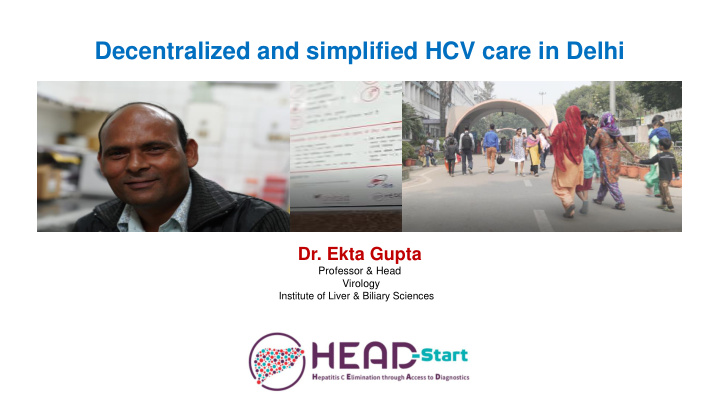



Decentralized and simplified HCV care in Delhi Dr. Ekta Gupta Professor & Head Virology Institute of Liver & Biliary Sciences
Introduction • An estimated 12 – 18 million people are infected with Hepatitis C Virus (HCV) in India, accounting for a significant proportion of the global HCV burden. • In order to meet the ambitious 2030 targets for global reduction in hepatitis-related mortality by 65% and new infections by 90%, the Government of India launched the National Viral Hepatitis Control Program in 2018. • Accelerating the elimination of Hepatitis C globally is not possible without increasing the access to testing services. Objective: Decentralized testing services in a hub and spoke manner were initiated in Delhi, India as a pilot model.
Methodology Arm3: Arm1: Arm 2: Outreach Hospital Screening Partially decentralized Screening n = 5 Hospitals screening n = 15 polyclinics RDT at screening camps RDT Screening at hospitals RDT screening at polyclinics Patient referred to hospital for Sample collected from Patient referred to hospital confirmatory tests-sample HCV Ab+ and sent same for confirmatory tests-sample collection day to ILBS collection Confirmatory testing at central Confirmatory testing at central Confirmatory testing at lab (ILBS) lab (ILBS) central lab (ILBS)
Sites Hospital Polyclinics 1 Maharishi Valmiki Punjabi Colony Rohini Sec 18 Rohini Sec 4 2 Sanjay Gandhi Wazirpur Rohini Sec 2 Saraswati Vihar 3 Deen Dayal Tilak Vihar Pitampura Rani Bagh Upadhaya 4 Pt. Madan Mohan Basant Gaon Timarpur Kashavpuram Malviya 5 Guru Teg Bahadur Vivek Vihar Nand Nagri Kanti Nagar
HCV care cascade; preliminary data 900 45000 786 (2.0%) 38768 800 0 0 704 (89.6%) 40000 0 0 0 0 700 606 (86.1%) 35000 0 0 600 494 (81.5%) 0 435 (88.1%) 30000 500 0 407 (93.6%) 0 0 0 0 400 25000 244 (60.0%) 235 (96.3%) 300 0 0 0 20000 0 200 15000 100 0 10000 RDT + HCV RNA HCV RNA + t/t initiated t/t completed Eligible for SVR tested Cured tested SVR 5000 786 606 704 435 407 494 244 235 0 0 0 0 0 0 0 0 0 0 0 0 0 0 0 0 0 RDT screened RDT + HCV RNA tested HCV RNA + t/t initiated t/t completed Eligible for SVR SVR tested Cured
Single site and most effective Cumulative Cascade Site Type % RNA tests % Tx Initiation retention Hospital , direct 92.7%* 88.1%** 81.7% Polyclinics, referred 48.4% 34.2% 16.6% *p<0.001 **p=0.003 Site Type % RDT+ District Hospitals 3.1%* Polyclinics 1.6% *p<0.001
Conclusion • This hub and spoke model of decentralized HCV care provision at point of care (PoC) proved to be effective in resource limited Indian scenario. • Connecting centralized lab to several peripheral sites via sample referral as compared to patient travel could help in better patient retention. • One-point referral system to be adopted in order to retain patients in the cascade of care. • It paves way to eliminate HCV through primary health care as PoC with existing resources in Public health settings in India. • The results can be very helpful in guiding policies for increasing the uptake of testing at a larger scale.
Acknowledgements Prof. S.K. Sarin, Director ILBS. Dr Sundeep Miglani, Addl Director DGHS. All the nodal officers at the five hospitals in Delhi. FIND Delhi office. Clinton Health Access Initiative (CHAI). WHO India. WHO Global Hepatitis Program. National Viral Hepatitis Control Program. The patients who participated in this program. Technical staff and Data entry operators. Unitaid for its funding and support.
Recommend
More recommend